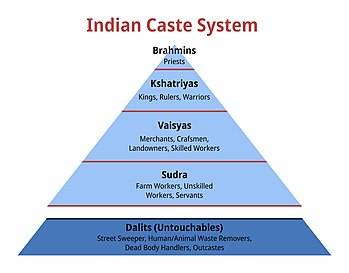Caste
The caste system is a system in India that was once mainly used by Hindus. This system has been generally accepted for about 3000 years. There are four castes in this system and one outcast group is regarded as "untouchables". There are also castes in countries other than India as the system spread to South Asia about 2000 years ago. For centuries, this system has dictated one's marriages, geographical location, and occupation. People must not marry someone from another caste, and they must not do things that another caste does. The Indian government today works to decrease this discrimination with the quotas set in government jobs in 1950.
- Brahmin - priests and scholars
- Kshatriya - warriors and kings
- Vaishya - merchants and landowners
- Shudra - peasants and labourers
- Untouchables or Dalits - came much later after the other four groups and consisted of people who did jobs considered ritually polluting. This included sweeping ashes after cremations, ridding of animal waste, or skinning animals such as cows.

A census in 2023 of the 130 million people in Bihar collected information about castes for the first time since 1931. 15.5% were upper caste. 27.1% were other backward class. 36% were extremely backward class and 21.4% were scheduled castes or scheduled tribes. Brahmins, the highest caste, were less than 4% of the population.[1]
References change
- ↑ "India's caste census becomes election faultline as opposition targets Narendra Modi". www.ft.com. Retrieved 2024-05-08.